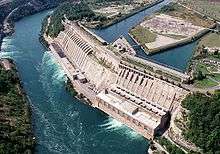Renewable energy in Canada

Canada generates a significant majority of its electricity from hydroelectric dams (59% in 2006). Wind power is growing quickly with Canada in 2011 being the 6th largest producer of wind power in the world.[1] Canada has built a number of photovoltaic power plants, mainly in Ontario, with one in Sarnia being the largest in the world at the time of construction. A 15 megawatt tidal plant sits at Annapolis, Nova Scotia, and uses the daily tides of the Bay of Fundy. Politicians have expressed interest in increasing the percentage of Canada's electricity generated by renewable methods. Ontario has created a subsidy to assist wind and solar power producers.
Sources
Hydroelectricity
Canada has about 75 GW of installed hydroelectric capacity, producing 392 TWh of electricity in 2013.[2] Manitoba, British Columbia, Newfoundland and Labrador, Yukon and Quebec produce over 90% of their power from hydroelectricity. Quebec generates half of Canada's hydroelectric power.
Solar power
Canada has plentiful solar energy resources, with the most extensive resources being found in southern Ontario, Quebec and the Prairies. The territories have a smaller potential, and less direct sunlight, because of their higher latitude.[3]
With 1210 MWp of installed photovoltaics in 2013, Canada ranked 15th among the world's countries.[4] Ontario has a program of moving away from coal and promoting renewable resources which has led to a number of industrial-scale photovoltaic plants being built. Located in Sarnia, Ontario, the 97 megawatt[5] Sarnia Photovoltaic Power Plant was briefly the largest solar farm in the world (in October 2010) and can power more than 12,000 homes.[6] Other plants include the 23.4 MW Arnprior Solar Generating Station and a 68 MW solar farm is in Sault Ste. Marie.
Until recently, the main applications of solar energy technologies in Canada have been for non-electric active solar system applications for space heating, water heating and drying crops and lumber. In 2001, there were more than 12,000 residential solar water heating systems and 300 commercial/ industrial solar hot water systems in use. These systems presently comprise a small fraction of Canada’s energy use, but some government studies suggest they could make up as much as five per cent of the country’s energy needs by the year 2025.[3]
Canada has many regions that are sparsely populated and difficult to access. Photovoltaic (PV) cells are increasingly used as standalone units, mostly as off-grid distributed electricity generation to power remote homes, telecommunications equipment, oil and pipeline monitoring stations and navigational devices. The Canadian PV market has grown quickly and Canadian companies make solar modules, controls, specialized water pumps, high efficiency refrigerators and solar lighting systems.[3]
One of the most important uses for PV cells is in northern communities, many of which depend on high-cost diesel fuel to generate electricity. Since the 1970s, the federal government and industry has encouraged the development of solar technologies for these communities. Some of these efforts have focused on the use of hybrid systems that provide power 24 hours a day, using solar power when sunlight is available, in combination with another energy source.[3]
Wind power

As of June 2015, wind power generating capacity was 10,204 megawatts (MW), providing about 4% of Canada's electricity demand.[7] Ontario, Quebec and Alberta each had more than 1000 MW of nameplate capacity. All provinces and territories, except Nunavut, had some commercial wind power in 2012.
Local policies
Ontario
Ontario's Green Energy and Green Economy Act, 2009 (GEGEA), now in force and effect, takes a two-pronged approach to creating a renewable energy economy. The first is to bring more renewable energy sources to the province and the second is the creation of more energy efficiency measures to help conserve energy. The bill also appoints a Renewable Energy Facilitator to provide "one-window" assistance and support to project developers in order to facilitate project approvals. The approvals process for transmission projects are also streamlined and for the first time in Ontario, the bill enacts standards for renewable energy projects. Homeowners now have access to incentives to develop small-scale renewables such as low- or no-interest loans to finance the capital cost of renewable energy generating facilities like solar panels.[8]
See also
- Energy policy of Canada
- Wind power in Canada
- Solar power in Canada
- Geothermal power in Canada
- Hydroelectric power in Canada
References
- ↑ "Worldwide Electricity Production From Renewable Energy Sources: Stats and Figures Series: Fourteenth Inventory – Edition 2012" (PDF). 2.2 Electricity Production From Wind Sources: Main Wind Power Producing Countries – 2011 (text & table): Observ'ER. Retrieved 15 January 2013.
- ↑ "IEA - Report". www.iea.org. Retrieved 13 June 2016.
- 1 2 3 4 Solar power in Canada
- ↑ BP Statistical World Energy Review 2014 (XLS), retrieved 29 January 2015
- ↑ Large-scale photovoltaic power plants ranking 1 - 50
- ↑ "Enbridge completes Sarnia solar farm". CBC News. 4 October 2010.
- ↑ Canwea (May 1, 2014). "Powering Canada's Future" (PDF). Canwea.
- ↑ Ontario Unveils Green Energy and Green Economy Act, 2009
